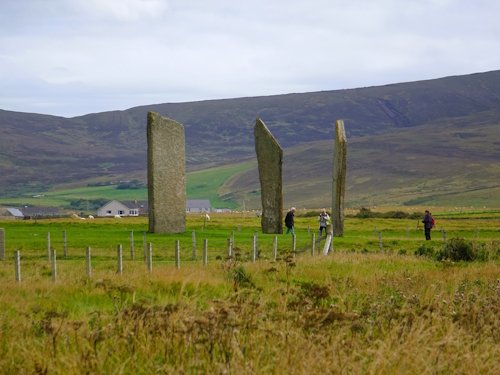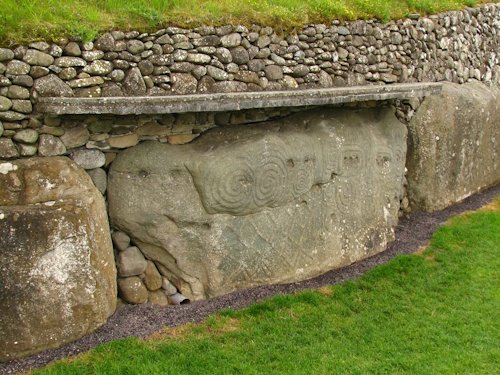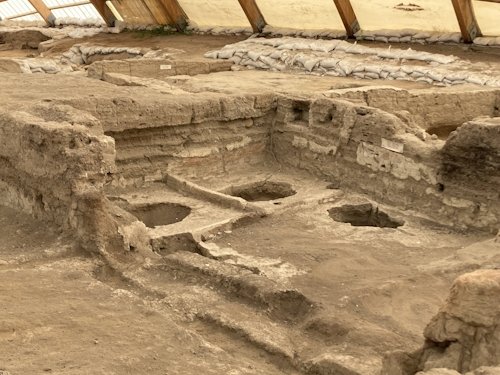Our Connection ‘ Neolithic Age ’ groups all WHS correlating with the Neolithic period. Some derive their OUV from it, while others only have a slight link because archaeological strata from that era have been found below later more important findings.
The Neolithic is the Later Stone Age, a period that timewise differs across the continents but is characterized by the introduction of farming, domestication of animals, and change from a hunter-gatherer lifestyle to one of settlement . It was predated by the Palaeolithic and Mesolithic and followed by the relatively short transformation period of the Chalcolithic (a.k.a. Copper Age) before the Bronze Age started.
I updated the Connection and set out to find which sites can be considered the Top Neolithic WHS. And I learned a few things along the way…

Inventory
We already had 55 connected sites. I checked them all for their rationale, updated the texts, and removed two (Vredefort Dome and Rapa Nui). I then did a query on the UNESCO website with the term ‘Neolithic’. This resulted in 42 hits, including 12 previously unconnected ones such as the Antequera Dolmens and Ephesus . The Wikipedia page on the Neolithic also has a list of sites, from which I picked Horton Plains ( Central Highlands of Sri Lanka ).
5 of the final 66 are also in the connections for Palaeolithic and Mesolithic, 2 in Chalcolithic and 10 in Bronze Age, which shows that sites usually aren’t typically Neolithic only. The Americas aren’t considered to have had a Neolithic age, the corresponding era here is the Formative Stage but it has different characteristics.
Finding ‘the best’
So where do you need to go to see what makes the Neolithic Neolithic? Three WHS are so quintessentially Neolithic that they have the term in their full site name: the Heart of Neolithic Orkney , the Neolithic Flint Mines of Spiennes , and the Neolithic Site of Çatalhöyük .
I ranked the list that I compiled above against the following criteria, handing out one point max per criterium:
Neolithic as an explicit part of the OUV
Here interpretation and additional research came into play. Sometimes the term ‘Neolithic’ is used in an OUV statement, but the OUV criteria on which it was inscribed point elsewhere. Byblos for example is said to be “Continuously inhabited since Neolithic times”, where the rationale behind the criteria focuses on the Bronze Age and the Phoenician era. In cases like this, I did not reward a point.
Another issue that arose is determining whether a site is truly Neolithic. Sarazm for example, does its OUV date back to the very end of the Neolithic or is it Chalcolithic? With its focus on metallurgy in crit ii and iii (see also this ) I’d veer to Chalcolithic, but it existed in the Neolithic already as a settlement (it did inspire a new connection BTW: Proto-Cities ). And for Malta’s Megalithic Temples , Wiki says Neolithic and UNESCO says Bronze Age. With an OUV relying on technical stoneworking skills, Neolithic seems more appropriate (also because the Ggantija temples are older than the Hypogeum of Hal Saflieni, which is labelled as Neolithic everywhere). When in doubt, I rewarded half a point.
Neolithic aspects are visible
Nan wrote in his Jericho review "As a Neolithic site, this is probably as good as it gets". Solivagant's Choirokoita review makes a difference between Neolithic megaliths and Neolithic settlements, and he deemed the latter as "there is very little for the untrained eye to see". To appreciate the remains of so long ago may require using a Stoclet Pass (the oldest of the notorious Pile Dwellings are also from the Neolithic), but the best of them still offer something good to look at. Those are way more elaborate than simple dolmen or foundations of buildings.
I’ve awarded the points mostly following the site rating (0.5 for sites with an average score below 3, 1 for those at 3 or more), after making sure that what you’re looking at is indeed the Neolithic part and whether there is anything to see at all.

The Top Sites
I ended up with the maximum score of 2 for:
- Neolithic Orkney : for Skara Brae, "unparalleled amongst Neolithic settlement sites in northern Europe." (Photo 1 shows the Stones of Stenness Circle, also part of this WHS)
- Petroglyphs of the Lake Onega and the White Sea : for its "coherent image of the Neolithic culture period in the northeastern part of Fennoscandia" (other rock art sites date back to the Neolithic as well, but tend to span long periods with most visible remains of a later date)
- Brú na Bóinne : for its grand passage tombs and rock carvings (Photo 2 shows carvings at Newgrange)
- Stonehenge : for its architecturally sophisticated stone circles
- Hal Saflieni Hypogeum : the only known subterranean ‘labyrinth’ from the period, excellently preserved
- Göbekli Tepe : for its innovative building techniques
- Çatalhöyük : for its house clusters, characterized by their streetless neighbourhoods (Photo 3)
Runners-up, with a score of 1.5, are Neolithic Flint Mines at Spiennes, Antequera Dolmens, Choirokoitia , Krzemionki prehistoric flint mines , Ancient Jericho, Liangzhu Archaeological Site , Megalithic Temples of Malta, and the Jomon Prehistoric Sites (the Jomon period is considered "the Neolithic of Japan").
You can find the full spreadsheet here to see how I determined the scores (or calculate your own).

Missing Neolithic WHS
Europe and the Middle East seem already well-represented among the Neolithic WHS. Arabia and Africa have some too, although less spectacular. One might expect more however from the Indian subcontinent and China. A site that I came across repeatedly is probably the Top Missing Neolithic site: Mehrgarh in Pakistan (a TWHS) - "Located in the Indus Valley, Mehrgarh is one of the earliest known Neolithic settlements in South Asia, dating back to around 7000 BCE. Evidence suggests a transition from a hunter-gatherer lifestyle to a settled agricultural community, with domesticated wheat and barley found at the site."
Do you enjoy visiting Neolithic sites?



